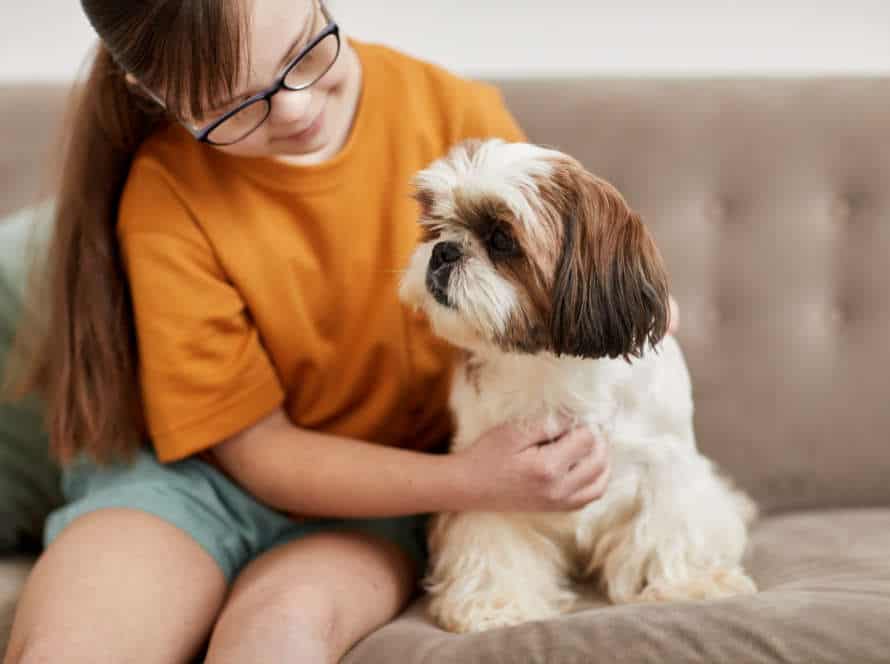Misreading Your Puppy’s Signals: Common Misconceptions
Heading: Average Salaries in Top 5 Major Cities in the US.
Misconception: Growling Means Aggression
Growling from puppies? Not always aggressive! In fact, it’s their way of expressing a range of emotions. It’s important to recognize the context. Is it fear or aggression? Know this and you’ll be ready to respond in a positive way.
Understanding the different types of growling
Growling is a form of communication that dogs use. It can mean different things depending on the context. However, many people mistakenly believe it’s always aggressive.
Here are some types of growling and their meanings:
- Play growling: Dogs often do this during playtime. It’s usually accompanied by a wagging tail and relaxed body language.
- Fear growling: When scared or threatened, a dog may growl as a form of self-defense. They may also cower or back away.
- Pain-induced growling: Dogs may growl if injured or in pain, as a warning to prevent further harm.
- Territorial growling: Dogs may growl to protect their territory, like food or toys.
It’s important to understand why your dog is growling. Always consult a professional if you’re not sure about your dog’s behaviour.
Identifying growling triggers
Growling in dogs can often be mistaken as a sign of aggression. However, it really is just their way of expressing discomfort or fear. To understand your pooch’s behavior better, figure out what triggers it.
Common triggers can be:
- Fear & anxiety
- Pain or uneasiness
- Feeling threatened about their territory or possessions
- Being over-excited
- Sudden reactions to touch or pressure.
By recognizing these triggers, you’ll be able to provide a secure and suitable atmosphere for your dog. Don’t forget that growling is their natural way to communicate, and punishing them wouldn’t do any good. Be patient and use positive reinforcement techniques to address any issues.
Reacting appropriately to growling behavior
Many think growling by dogs is always hostile, but it can be a sign of normal communication. Here are some tips to handle it:
- Don’t punish them – this can make them more aggressive.
- Give them space – if they growl, they could be feeling the need to protect themselves.
- Observe them – growling can mean fear, unease, frustration or discomfort.
- Seek help – if growling becomes more frequent or intense, or if other aggressive behaviors occur, get help from an animal behaviorist.
Growling is one part of a dog’s ‘language’ and not always a sign of aggression. Reading their body language and responding suitably can help create a great relation between a dog and its owner.
Misconception: Tail Wagging Always Means Happiness
Many think tail wagging is a sign of joy. However, there are various other explanations. Contrary to popular opinion, a wagging tail doesn’t always mean your pet is content. It may mean they’re scared, baffled, or mad. Let’s look at some common misunderstandings about tail wagging.
Understanding the different types of tail wagging
Tail wagging is a common way for dogs to communicate, but it doesn’t always mean they are happy.
Different types of tail wagging can show many emotions and intentions.
For example, there’s the “Broad wag“. This type is wide and sweeping and suggests happiness and relaxation.
Then, there’s the “Stiff wag“. It’s slow and stiff, with the tail high, which indicates alertness or tension.
Lastly, there’s the “Low wag“. It’s quick and tight, with the tail low, meaning the dog is feeling insecure.
It’s important to watch for other body language cues too.
Puppy owners must be mindful of these tail wagging types to build better pet communication and a strong relationship.
Recognizing the context of tail wagging behavior
We, as pet owners, tend to interpret our pup’s tail wagging as a sign of joy. However, it can actually signify a range of emotions, hinging on the context. Comprehending the circumstance of their tail-wagging is key in fostering a strong bond with your four-legged friend.
Here’re some examples of how context impacts tail-wagging:
- High wagging: A high-wagging tail implies they are excited or interested in something.
- Low wagging: Low wagging possibly displays submission or fright.
- Slow wagging: A slow wag suggests doubt or indecision.
- Fast wagging: Fast wagging often hints at happiness or playfulness. But, it could also signify over-stimulation or irritation.
Recognizing the context of your doggo’s tail wagging will enable you to answer fittingly and ultimately advance your communication & relationship with your pup.
Discerning when your puppy is anxious, nervous or stressed
As a pup parent, it’s vital to recognize the signs of anxiety, nervousness, and stress in your pup. Tail wagging isn’t always a sign of happiness. Being aware of these signs is key in taking care of your pet’s needs. Here are a few to look for:
- Excessive slobbering, panting, or yawning.
- Restlessness or hyperactivity.
- Avoiding eye contact or hiding.
- Persistent whining or barking.
- Tail tucking or low ears.
- Licking or biting themselves.
It’s essential to address your pup’s anxiety and stress with care and patience. This can improve their well-being and make anxiety-provoking situations easier in future. Pro tip: Socializing with other dogs and getting proper training can help reduce your pup’s stress and anxiety levels.
Misconception: All Licking is Affectionate
Canines’ behaviour is often misconceived. It’s true, licking can mean your pup loves you. But, it can also mean anxiety, stress or insecurity. To understand your pup’s body language, you must know the different meanings behind their licks.
Understanding different types of licking behavior
Licking is a habit of dogs often misunderstood as a sign of affection. Here are three types of licking and their meanings:
- Affectionate licking: Tail wagging and a relaxed body means they love you!
- Stress-induced licking: When they’re scared, anxious or tense, licks may increase. This can lead to skin problems – help your pup out by calming them down.
- Medical licking: Licking an injury can help it heal, but too much may mean an illness.
Know your pup and watch for clues to understand their licking behavior. That way, you can respond correctly and keep your bond strong.
Interpreting what your puppy is trying to communicate
It is key to understand that not all licking from your pup is a sign of affection. Dogs use licking to communicate and express different feelings. If you get it wrong, it can lead to misunderstandings and affect your behaviour towards them.
For example, lip licking can mean anxiety, discomfort or even illness, not necessarily hunger. Yawning too could be a sign of distress or appeasement, not just tiredness.
So, pay attention to other body language clues such as ears, tail and pose to get a better idea of what they are trying to say.
Pro Tip: Get to know your pup’s body language better to become more in tune with their needs and emotions, and strengthen the bond between you.
Respecting your puppy’s boundaries and reactions
Respecting your pup’s limits and responses is key for a healthy, happy bond. Misunderstanding your pup’s cues is common when you think all licking is loving. Licking can show affection, but can also mean stress, anxiety, or unease. Pay attention to body language, voices, and other behaviors to understand your pup correctly. Here are tips to respect your pup’s boundaries and reactions:
- Let them come to you, not force contact.
- Don’t punish or scold for growling, snarling, or avoiding.
- Learn the signs of stress and anxiety like panting, pacing, or too much barking.
- Give your pup enough space and time to adjust to new people and situations.
By respecting your pup’s boundaries, you’ll build trust and love, leading to a better relationship.
Misconception: All Jumping is Excitement
Misreading your pup’s signals is easy. You may think that every jump is from joy and friendliness. However, this isn’t always true. It could be a sign of something else. Let’s investigate why jumping isn’t always out of excitement.
Understanding different types of jumping behavior
Dogs’ jumping behavior can be complicated. It either reveals excitement or worry, or even a plea for attention. Let’s look into the different types.
- Excitement Jumping: Commonly, tail-wagging and playful doggy actions come with it.
- Anxiety Jumping: Signs are ears back, body tense, and tail tucked between legs.
- Negative Reinforcement Jumping: When a pup jumps to get attention and the owner backs away but pets it, the pup will keep jumping.
- Greeting Jumping: When a pup sees someone they know, they’ll jump with joy.
Interpreting what your puppy is trying to communicate
Many assume that their pup’s jumping is happy, however it could be a sign of anxiety, fear, or other negative emotions. To comprehend what your pup is trying to communicate, you must read their body language and understand their behavior.
Common misunderstandings when reading pup behavior are:
- Thinking tail-wagging means they’re joyful (it could also mean they’re anxious or scared).
- Thinking growling is always aggressive (it can also be juvenile and playful in social interactions).
- Believing jumping up on people is only an expression of excitement (it could be a sign of anxiety or a learned behavior due to separation anxiety).
Interpreting your pup’s language correctly will aid you in creating a great relationship with them and avoid unwanted behavior.
Pro tip: Watch your pup’s body language and consider the context of their behavior to interpret their signals accurately.
Training techniques to stop leaping and other unwanted behaviors
Leaping can be a problem in puppies. It can be a sign of excitement, but also stress, anxiety or fear. To stop it, here are some training techniques:
- Ignore the puppy when it jumps up, and give it attention when it calms down.
- Give treats or praise when it behaves well.
- Introduce the puppy slowly to situations that trigger jumping, like visitors or other dogs.
It’s important to understand your puppy’s signals and body language. Misreading can lead to wrong assumptions.
Misconception: Submissive Behavior is Always Good
Dogs and their owners can have misunderstandings. People think all submissive behavior is good, but it’s not always true. It’s important to know what signals a pup is sending. Here are some common misconceptions about submissive behavior.
Understanding different types of submissive behavior
Submissiveness in canines isn’t always a great thing. There are many different types of submissive doggy behaviours, some of which could suggest issues. Here are three types and their meanings:
- Passive submission: A passive pup will cower, slump its body and even pee in reaction to a person or other animal’s presence. Over-responding to this can worsen the pup’s fear and anxiety.
- Active submission: An active submission is when a dog quickly lowers its body, maybe licking or nudging the person or pet it’s interacting with. This is usually friendly.
- Fearful submission: If a pup is afraid, it may flatten its ears, curl its tail between its legs and avoid eye contact with the cause of its fear. This needs patience, understanding and positive reinforcement training.
Owner Tip: Recognize these types of submission and act suitably. Don’t punish a pup for being passive, as this will only worsen its trust issues and anxiety. Focus on positive reinforcement and behaviour modification techniques to help your pup feel secure.
Identifying whether your puppy is fearful or over-stressed
Submissive behavior in puppies is often misunderstood. It can indicate fear or over-stress.
Signs of fear or over-stress: whimpering, cowering, hiding, growling, panting, and snapping or biting.
Triggers: loud noises, unfamiliar people/environments, physical discomfort.
As an owner, it’s essential to identify these signs and take action. Ignoring or punishing submissive behavior can lead to more fear and anxiety.
Tips to help your pup:
- Gradually introduce them to new people, sounds, and environments.
- Create a safe, comfortable space for them to retreat to.
- Reward positive behavior with treats and praise.
- Consult a vet or professional dog trainer, if needed.
Dealing with stress and anxiety in your puppy
Submissive behavior in puppies often mistakenly viewed as a good thing. However, it may indicate anxiety, fear, or stress. It’s important to tell the difference between submissive and anxious behavior.
Signs of submissive behavior include:
- tucking their tail,
- avoiding contact, and
- lying on their back.
Anxious behavior could be:
- shaking,
- drooling too much,
- hiding,
- acting destructively,
- barking a lot, or
- becoming aggressive.
As a pet owner, it’s your job to learn about your pup’s behavior. Socializing, training, and exercising them can help reduce their anxiety.
Pro Tip: Reinforcing positive behaviors with treats, praise, and rewards can help lower their stress levels.
Misconception: All Barking is Bad
Puppies bark – it’s not always naughty. It’s a form of communication! It could mean they’re excited, scared, or just protecting themselves. But, there are some misconceptions around puppy barking. Let’s look closer and understand their signals better.
Understanding different types of barking behavior
Barking is a natural thing for dogs. Not all of it is bad. It’s essential to know the types of barking, so pet owners don’t misread their dog’s signals and create behavior problems.
Types:
- Warning bark: A short bark to alert their owner of something odd.
- Attention bark: A higher-pitched bark to get their owner’s attention or get them to play.
- Play bark: A repeated bark plus wagging tail & playful body language when wanting to play.
- Fear bark: A high-pitched bark when scared, anxious, or spooked.
- Aggressive bark: A deep, continuous bark with signs of aggression, like snarling, baring teeth, or growling.
Understanding these types of barking can help pet owners address the dog’s needs & work on unwanted behavior.
Pro Tip: Dogs bark to communicate. Recognize the message & respond to keep a healthy and happy relationship.
Discerning when your puppy is anxious, nervous or stressed
It is important to be able to tell if your pup is anxious, nervous, or stressed. Don’t think that all barking is bad. It may just be a way for your pup to show it is feeling uncomfortable.
To be able to tell if your pup is feeling anxious, look for the following signs:
- Panting, pacing, or whining
- Ears flattened or erect
- Tail tucked or held high and rigid
- Excessive licking, yawning, or shedding
- Dilated pupils or avoiding eye contact
If you see any of these behaviors, take a pause and see what’s causing them. Make a secure and cozy environment for your pup and limit situations which make them stressed. Be patient and eventually you will have a better understanding of your furry pal.
Techniques to stop barking and encourage good behavior
It’s wrong to think that every bark is bad. Dogs bark to communicate. But too much barking can be annoying and may show a problem in behavior. Here are a few tips to help your dog act better and reduce barking:
- Positive Reinforcement: Reward your pup when they stay quiet or listen to commands. This’ll make them do it again.
- Triggers: Figure out what makes them bark, like people or events. Then, remove or manage the trigger.
- Exercise: Regular exercise will get rid of extra energy and nervousness, which can lead to loud barking.
- Training: Get an expert trainer to help with behavioral issues and teach them good habits.
It’s essential to understand how your dog talks and know when it’s okay to bark. With time and consistency, you can make your pup a good part of the home.
Frequently Asked Questions
1. Why is it important to understand my puppy’s signals?
Understanding your puppy’s body language and vocal cues is crucial for effective communication and building a strong bond with your furry friend. This can help prevent misunderstandings, misinterpretations, and stressful situations for both you and your pet.
2. Can my puppy’s tail wagging always indicate a happy mood?
No, a wagging tail does not always mean your puppy is happy. They may also wag their tail when they’re feeling anxious, fearful, or even aggressive. It’s important to consider the context, other body language signals, and your puppy’s overall behavior to accurately interpret the meaning behind the tail wagging.
3. Is it true that a yawn from my puppy always means they’re sleepy?
No, yawning can indicate a variety of emotions in dogs, including stress, anxiety, confusion, and even hunger. Yawning can also be contagious and your puppy may yawn when they see you yawning or when they’re feeling bored.
4. Are growling and snarling always signs of aggression in puppies?
No, growling and snarling can also be playful vocalizations for some puppies. However, it’s important to pay attention to the context, body language, and other signals like raised fur or stiff posture, which may indicate that your puppy is feeling threatened or uncomfortable.
5. Can my puppy’s licking always indicate affection?
No, while licking can be a sign of affection, puppies may also lick when they’re feeling anxious or stressed. They may also lick to communicate something, like asking for food or attention. It’s important to observe your puppy’s overall behavior and other signals to understand the context behind their licking.
6. What should I do if I misinterpret my puppy’s signals?
If you’re not sure what your puppy is trying to tell you, it’s best to err on the side of caution and assume they’re feeling anxious or uncomfortable rather than aggressive or playful. Avoid punishing or scolding your puppy and try to remove them from the situation if possible. Consider enrolling in a puppy training class or consulting with a professional dog behaviorist for guidance.







